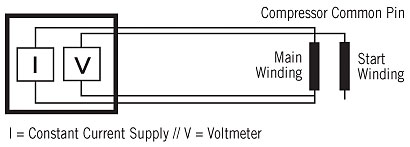Motors are developed according to this temperature norm. As a result, in the calorimeter tests for motor overheating or overload protector tripping, the limit of 130 degrees is never exceeded. These tests are carried out under standard conditions. The actual compressor is designed within the limits these conditions represent, so the compressor will run safely.
Sometimes the actual operation conditions can't be positioned within standard test limits. However, this doesn't mean the compressor will run in an unsafe manner.
Normally, not all the operating conditions will simultaneously exceed those values. Actual applied voltage may decrease below the standard limits if suction and discharge pressures are kept far enough from the standard overload parameters. Or, actual ambient temperatures can rise above the established one if voltage and pressures are within a narrow range of values.
In these circumstances, the winding temperature is still the optimum measurement to ensure the necessary conditions are maintained for safe operation.

Finding The Winding Temp
The winding temperature measurement is not a directly read value. Some companies consider the shell temperature is a good enough indication of the internal temperature. This, however, can lead to meaningless errors.The heat exchange between the motor windings and the shell depends mainly on the compressor design - i.e., better heat transfer from the windings to the oil (windings immersed in oil) and from the oil to the shell (oil pump efficiency).
This results in possible temperature differences of more than 10K between the shell and the windings. When good heat exchange is achieved, this can indicate that the warmer shell is helping to maintain cooler windings.
To read the winding temperature, we measure the motor winding resistance. For resistance start induction run (RSIR) and capacitor start induction run (CSIR) motors, only the main winding temperature needs to be considered. But for permanent split capacitor (PSC), capacitor start-capacitor run (CSR), and resistance start capacitor run (RSCR) motors, both start and main windings need to be checked. (See Figure 1.)
Winding resistance increases with the winding temperature because the copper resistivity increases with temperature. The law of resistance variation is well established. It allows us to figure out the winding temperature when we know the resistance at a given temperature.
Let's say the reference temperature (T0) is 32 degrees C. To determine winding resistance (R0), we put the appliance concerned in a test room at 32 degrees ambient, and leave it there for 24 hours without operating. After that time is up, we measure the winding resistance. That reading is the R0.
Errors And Accuracy
The accuracy of our measuring instrument needs to be around 0.01 ohm. An error of 0.1 ohm in a compressor for a domestic refrigerator with a resistance of 25 ohm at 25 degrees represents a miscalculation of 1.04 degrees in the winding temperature.If the same error is made in an air conditioning compressor of 1.5-ohm resistance, the temperature miscalculation will be 173 degrees.
To prevent the measuring instrument's connecting leads' resistance from affecting the calculations, we prefer using a four-wire bridge to the traditional Whetstone bridge. Basically, a four-wire bridge consists of a constant current supply and a voltmeter.
The voltage drop in a motor winding depends only on its resistance; the connecting leads do not affect it. This voltage is read at the compressor pins. As the current is known, we can calculate the winding resistance from the ratio between the voltmeter reading and current. The calculation is made automatically; the instrument displays the resistance value. The market currently offers different types of four-wire resistance bridges and multimeters, which incorporate this principle for resistance measurement.
Winding resistance must be read within a few seconds of switching off the compressor, immediately after the motor heating test is finished, so that you aren't reading changes in the winding temperature. If this can't be done, take a number of resistance readings after various time intervals; plot these values back to zero on logarithmic paper.
Sometimes you need to measure the winding temperature (winding resistance) under running conditions. In such cases, it's not possible to use the previously mentioned test instrument. Nevertheless, other devices on the market allow a Whetstone bridge to be connected to a running motor, albeit with some loss of accuracy.
Take special care when you are testing a motor with a disc-type overload protector (generally used in domestic and commercial refrigeration or air conditioning systems). If the motor reaches a temperature near to the overload protector's trip-out temperature, the disc will begin to move, causing high contact resistance. If you believe such a motor will run extremely hot, short out the overload protector to prevent errors in the resistance reading.
Miquel Jornet Salo is the application-engineering director for the Commercial Cold Division of Appliances Components Companies (ACC), Pordenone, Italy; www.the-acc-group.com. He can be reached at info@cubigel.com. The company makes compressors and motors for residential, commercial, and industrial applications.
Publication date: 04/04/2005

Report Abusive Comment